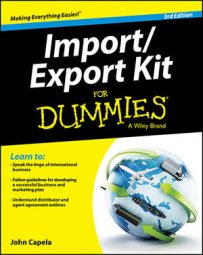Most companies begin their initial involvement in international business by exporting or importing. Exporting is sending goods out of your country in order to sell them in another country. Importing is bringing goods into your country from another country in order to sell them.
Both of these approaches require minimal investment and are, for the most part, free of major risks. They provide individuals and companies with a way of getting into international business without the commitment of significant financial resources, like the kind required to actually set up shop overseas.
Exporting: Do they want what you've got?
Exporting comes in two major forms:
Direct exporting: Direct exporting is a business activity occurring between an exporter and an importer without the intervention of a third party. This option is good for existing businesses that are looking for ways to expand their operations.
Indirect exporting: Indirect exporting is easier than direct exporting. It involves exporting goods through various intermediaries in the producer's country. Indirect exporting doesn't require any expertise or major cash expenditures, and it's the type of exporting used most often by companies that are new to exporting.
As you gain experience in doing business internationally, you may want to move from indirect exporting to direct exporting. You'll have greater control over the sales and distribution of your products.
Looking at types of indirect exporting
Indirect exporting can include the use of an export management company or something called piggyback exporting.
An export management company (EMC) is a private company based in the United States that serves as the export department for several manufacturers, soliciting and transacting export business on behalf of its clients. EMCs normally take title to the goods and assume all the risks associated with doing business in other countries. Using an EMC is helpful when you're new to exporting or you don't have a distributor or agent in a foreign country.
Entrepreneurs not interested in manufacturing can get involved in exporting by setting up an EMC. An EMC usually specializes in a product category. If you have a network of overseas contacts, some general product knowledge, and a desire to start an export business, contact American manufacturers who aren't actively exporting and offer your services.
Piggyback exporting is a foreign distribution operation in which your products are sold along with those of another manufacturer. Companies that have related or complementary but noncompetitive products use this form of exporting.
For example, say that you have a company that manufactures hairbrushes. You're not yet exporting, but you're interested in selling your hairbrushes in Italy. You just don't want to assume any risks or deal with major headaches. Across town is a company that makes shampoos. It's a well-established manufacturer and exporter of a line of shampoo products — and it's currently selling its entire product line in the Italian marketplace. In piggyback exporting, you approach the shampoo company and offer to let that company represent and sell your hairbrushes in Italy.
Why would the shampoo company be interested in such a deal? Because this setup lets the shampoo company offer a more complete line of products to its distributors with little to no additional investment. The shampoo company profits either by purchasing the hairbrushes and adding on a markup or by coordinating a commission arrangement with you.
Doing direct exporting
In direct exporting, you do your own exporting. Companies usually export directly only after having exported indirectly for a while. If you're interested in direct exporting, you can choose one of three routes:
Use an agent. An agent is a company that acts as an intermediary but, unlike an EMC, doesn't take title to the goods. You appoint an agent in each market (or country), and the agent solicits orders, with goods and payment for the goods happening directly between you and the customer in the other country.
Appoint a distributor. You can appoint a distributor in another country; the distributer purchases goods, takes title, and serves the customers on your behalf.
Set up an overseas sales office. You can go to another country, perhaps rent a warehouse, set up an office, and distribute the goods to customers. In practice, you're exporting to yourself overseas.
Importing: Can you sell what they have?
Importers purchase goods in foreign markets and sell them domestically. An importer can be a small company that buys goods from distributors and manufacturers in foreign markets, or it can be a global corporation for which importing components and raw materials valued at millions of dollars is just one of its functions.
Because businesses face intense price competition, more companies are looking to the global marketplace to source products. Many nations have a well-educated and skilled workforce that earns salaries that are less than those of comparable workers in the United States. To remain competitive, U.S. companies import goods from suppliers in countries where costs are lower than they are domestically. This is true for both low-cost items and luxury items.
To determine whether the item you want to import is produced in foreign markets and, if so, where to find it, look for similar products that are being sold in your country. Examining the product can tell you where it's made and, often, by whom. The U.S. Customs service requires that all goods be labeled with the country of origin on each product or on its container if product-marking isn't feasible.

